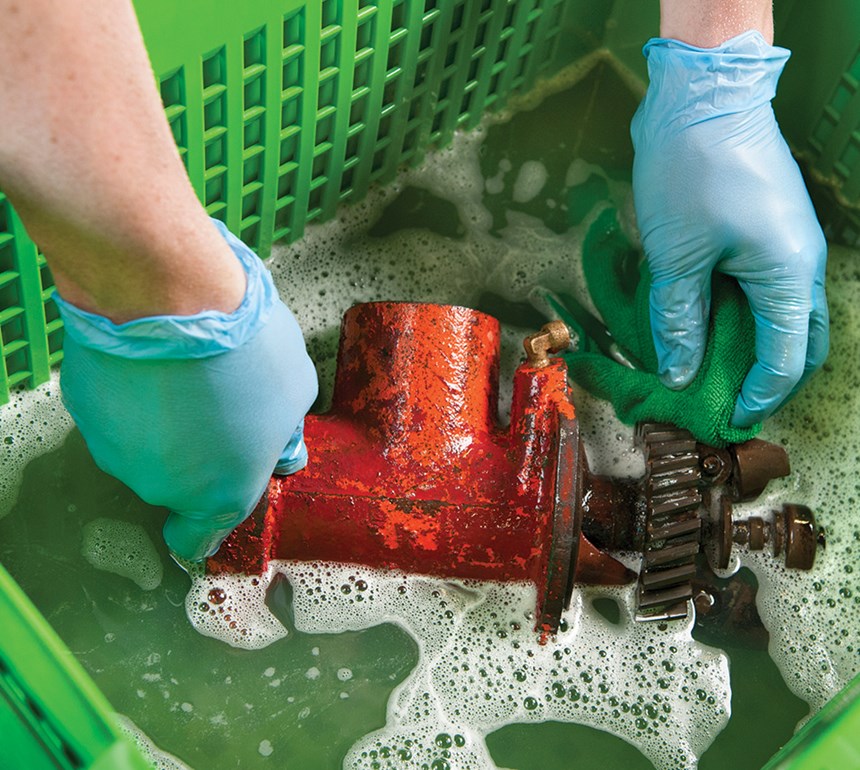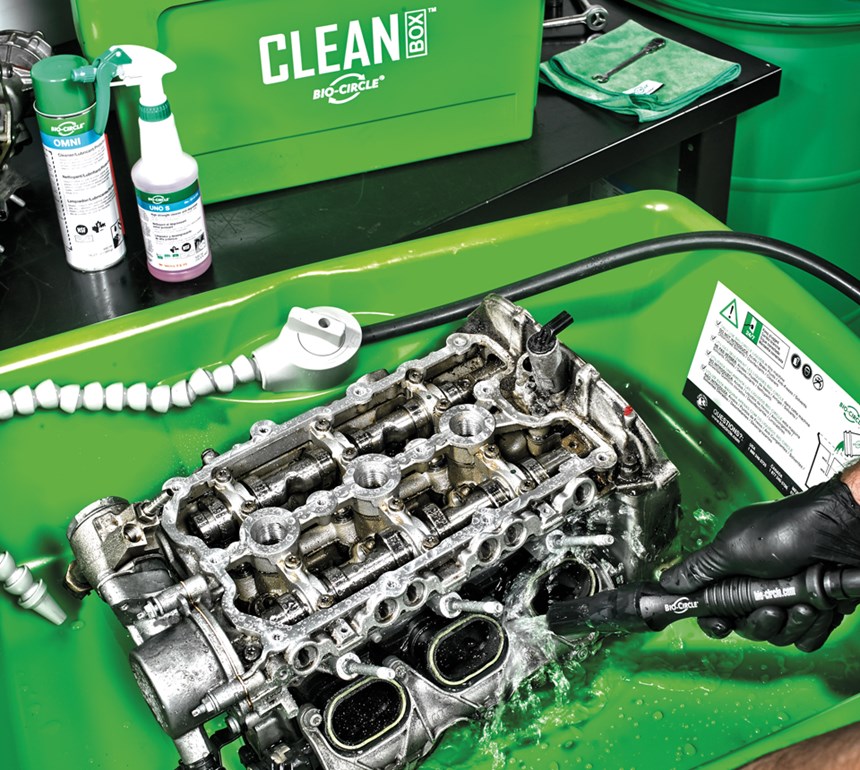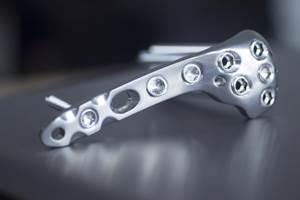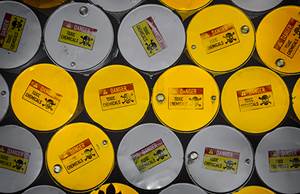Aqueous Cleaning Solutions Drive Safety and Profitability
The change to technologically advanced, environmentally friendly cleaning solutions can help contribute to a safer, more sustainable and more profitable workplace.
For more than a century, manufacturers, maintenance and repair operations and armed forces have used toxic solvents to clean contaminants from metal parts. However, as trichloroethylene and other solvents have come under increased scrutiny for their health and environmental risks, and as more companies have come to understand the benefits of safe and sustainable operating practices, solvent users have been seeking greener alternatives.
The emergence of aqueous (water-based) technology has brought a cost-effective, environmentally friendly option for cleaning and degreasing metal parts and components. Green solutions such as Bio-Circle cleaning products protect the environment, improve workplace safety and reduce industrial waste and operating costs.
What is Aqueous Cleaning?
Through the years, manufacturers have used a variety of hydrocarbon/organic solvents to clean and degrease metal parts. Some of the most commonly used solvents include trichloroethylene (TCE), methylene chloride, toluene, benzene, mineral spirits, methyl ethyl ketone and other hydrocarbons.
While chemical solvents are effective at removing grease and other fluids from metal parts, many of these solvents are harmful to workers and the environment. Perchloroethylene and trichloroethylene—two commonly used industrial solvents—are volatile organic compounds (VOCs) that have been linked to a number of health problems, including an increased risk of cancer.
In sharp contrast, aqueous cleaning solutions, which use water as the primary solvent, contain no VOCs. Unlike many petroleum-based solvents, aqueous cleaners are nonflammable. Overall, aqueous cleaners are less toxic than solvents. Several methods of aqueous cleaning are commonly used:
- Immersion cleaning—Parts are immersed in a cleaning solution, and some form of agitation and/or heat is added to supply the energy needed to remove contaminants.
- Automated washing—A high-pressure spray delivers more mechanical action to help remove soils from parts.
- Ultrasonics—A combination of water, a detergent and high-frequency sound waves creates bubbles that help to dissolve and displace particles from parts.
Although their cleaning methods differ from solvent-based systems, aqueous cleaners have proven to be just as effective. And because they are safer to use, aqueous cleaners offer a number of other advantages that can benefit the bottom line.
In one example, Inner-Tite Corp., a manufacturer of tamper-resistant security products for utility company devices, switched from a vapor-degreasing parts cleaning process to an aqueous cleaning system. The Holden, Massachusetts-based company was able to eliminate its use of TCE entirely. The factory became safer (employees no longer were exposed to TCE, a suspected carcinogen), and the company saved almost $2,500 per year in TCE purchasing costs.
By eliminating the annual use of 2,675 pounds of TCE, Inner-Tite no longer had to report its TCE usage to state environmental authorities, saving an additional $1,100 in annual regulatory reporting fees. And removing TCE from its facility reduced the amount of time dedicated to preparing for emergency response and complying with OSHA and environmental regulations while it lowered air emissions below the threshold for a minor-source generator.
Bio-Remediation
Bio-remediation is another twist on aqueous cleaning. The bio-remediation process has been occurring in nature for millions of years and has been harnessed recently to provide a safe, effective alternative to solvent-based cleaning systems.
In the bio-remediation process, live microorganisms within aqueous cleaning fluids break down oil, grease and other organic contaminants. Typically, the process takes place in a parts-cleaning sink, and the bio-remediating fluids require heat for optimal performance.
In much the same way that humans live by eating, breathing and producing waste, the microorganisms consume and digest the contaminants and convert them to harmless by-products—mostly water and carbon dioxide.
“It’s a very simple chemical equation,” explains Patrick LaPointe, vice president of research and development for Walter Surface Technologies Inc., which makes Bio-Circle aqueous cleaning products. “The microorganisms break the chemical bonds in the complex hydrocarbon chain, they derive some energy from the process, and the molecules take on a simpler chemical form as water and carbon dioxide. It’s a totally natural process.”
By converting oil, grease and other contaminants into harmless by-products, bio-remediation can help companies reduce their chemical-waste footprint—and not just on the factory floor. Bio-remediation has been used to help clean up large-scale environmental accidents, including the 2010 BP Deepwater Horizon disaster, which discharged almost five million gallons of oil into the Gulf of Mexico.
In Mr. LaPointe’s experience, most manufacturers shift to aqueous cleaners because they want to adopt products and processes that are safer for their workers and the environment. However, new customers are pleasantly surprised to learn that bio-remediating fluids (and aqueous cleaning fluids, in general) maintain their full cleaning power over a longer time period than solvents.
“The beauty of bio-remediation is that it is self-renewing,” Mr. LaPointe explains. “When you ‘feed’ these microorganisms with hydrocarbons, the microorganisms live on, and their initial cleaning power stays the same for several weeks.” Also, the cleaning agents in the solution will saturate at a much slower rate than solvents.
While solvent cleaners begin losing strength soon after their first use, requiring users to replenish their supplies after eight to 12 weeks, bio-remediating cleaners maintain their efficacy over the course of one to two years, according to Mr. LaPointe.
A Healthier Bottom Line
The use of solvents can lead to potential additional costs:
- Installing and maintaining ventilation and vapor-extraction equipment
- Contracting with a third party for management and disposal of spent solvents
- Paying higher fire insurance premiums associated with the use of flammable, petroleum-based solvents
- Investing in fire suppression equipment and emergency response training
- Paying regulatory reporting fees and OSHA/EPA noncompliance fines
Aqueous cleaning products, which are nontoxic, nonflammable and emissions-free, remove those costs from the equation.
Howard Case, maintenance manager for Leesta Industries Ltd., a Montreal-based manufacturer of aerospace components, says one of the key benefits of aqueous cleaning liquids such as Bio-Circle is that employees can use them without wearing burdensome personal protective equipment such as respirators. “It’s an excellent concept,” Mr. Case says. “The [Bio-Circle] liquid leaves no residue on the parts. It’s environmentally friendly. It’s warm, instead of leaving a cold feeling on the hands, so it’s easy to use. Its health rating is excellent, so you don’t need to take special precautions.”
By making the workplace safer, aqueous cleaning systems also mitigate the hidden costs associated with exposure to harmful solvents (such as the missed workdays and lost productivity resulting from chemical-related illnesses and injuries). Through the years, high-performing organizations have demonstrated that strong environmental, health and safety programs are linked to higher employee productivity, morale and job satisfaction as well as lower turnover.
“When you switch to an aqueous cleaning system, you’re not exposing your workers to a hazardous solvent anymore,” says Jason Marshall, laboratory director for the Toxics Use Reduction Institute’s cleaning laboratory in Lowell, Massachusetts. “Their stress levels will be a lot lower. Their PPE requirements will be a lot less. They’re going to feel a lot of the psychosocial benefits [of safety] that you really can’t put a price tag on.”
Even harder to quantify, but no less important, is the business value of investing in technology that supports workplace safety and environmental stewardship. As investors, customers and suppliers are placing an increasingly higher premium on environmentally friendly business practices, maintaining a robust safety and sustainability program can be a competitive advantage.
Not a Niche Anymore
Aqueous cleaning has evolved into a mainstream technology over the past two decades. Walter Surface Technologies, whose product portfolio includes bio-remediating and bio-renewable cleaning liquids and parts washers, now operates in seven countries. “Green cleaning isn’t a niche anymore,” Mr. LaPointe says. “We’re not talking about the early stages of technology here. This is mainstream, and more and more companies are adopting this technology, as it’s proven to be a reliable, safe and cost-effective method to clean parts.”
What EH&S Leaders Can Do Right Now
As regulators and corporations ratchet up their expectations for safety and sustainability performance, the role of the environmental, health and safety (EH&S) leader will continue to become more important. Here are some steps that these leaders can take today to make an immediate positive impact with aqueous solutions:
- Evaluate MRO and/or production processes and consider all of the dangerous chemicals that can be replaced with nontoxic, VOC-free solutions.
- Find a supplier that can help conduct a chemical audit to estimate the total cost (or cost improvements) of replacing existing solvents with sustainable solutions.
- Pilot-test sustainable, aqueous-based solutions in one location to measure effectiveness and real-world cost reductions.
- Deploy solutions across the entire organization once the benefits are proven.
- Become an advocate for sustainability—upstream to suppliers and downstream to customers—demonstrating that the organization “walks the talk.”
- Document the use case and demonstrate the cost savings and contribution to profitability to build support for further sustainability and safety initiatives.
Related Content
Kyzen Solvents Provide Ease of Cleaning for Medical Parts
The Metalnox line of solvent products are designed to improve reliability and increase the ease of cleaning in vacuum and vapor degreasing processes.
Read MoreVersatile Sandblasting for Deburring Intricate Geometries
PMTS 2023: Comco’s MicroBlasting sandblasting systems can deburr, texture and clean small, intricate parts.
Read More3 Common Filtration Questions Answered
Learn about the variety of filters for removing particulates from a cleaning fluid, how to determine cleaning fluid life and more.
Read MoreParts Cleaning Sector Shifts Energy Toward Regulatory Changes
With changes in EPA regulations regarding the use of some popular cleaning fluids, cleaning suppliers and end users are readjusting business strategies and/or cleaning processes to meet new requirements.
Read MoreRead Next
5 Aspects of PMTS I Appreciate
The three-day edition of the 2025 Precision Machining Technology Show kicks off at the start of April. I’ll be there, and here are some reasons why.
Read MoreDo You Have Single Points of Failure?
Plans need to be in place before a catastrophic event occurs.
Read MoreEmerging Leaders Nominations Now Open
Here’s your chance to highlight a young person in your manufacturing business who is on the path to be a future leader moving your company forward.
Read More

























